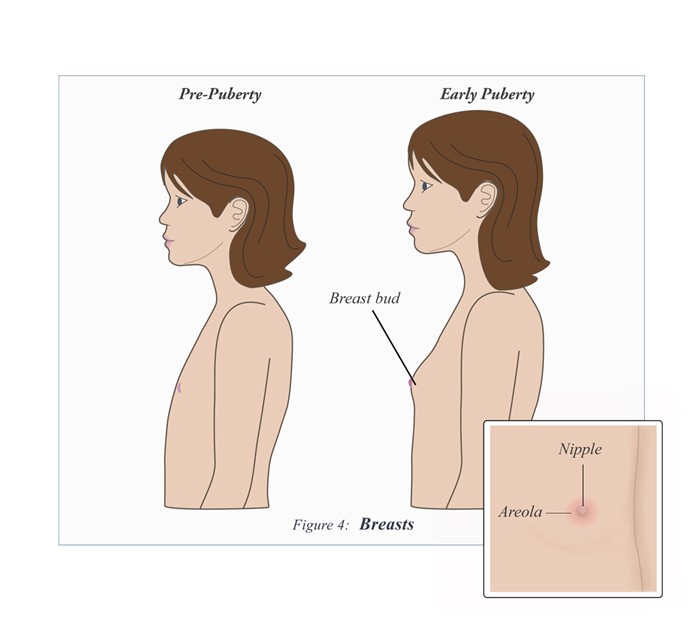The nurse is assessing a 13-year-old girl. Which event would the nurse expect to have occurred first?
Growth spurt
Evidence of pubic hair
Onset of menses
Development of breast buds
The Correct Answer is D
Choice A: Growth spurt is not the correct answer because it is not the first event that occurs in female puberty. The growth spurt is a period of rapid increase in height and weight that usually occurs between 10 and 14 years of age in girls. It is influenced by various factors such as genetics, nutrition, and hormones. Growth spurt usually follows the development of breast buds and pubic hair by about 6 to 12 months.
Choice B: Evidence of pubic hair is not the correct answer because it is not the first event that occurs in female puberty. Evidence of pubic hair is the appearance of coarse, curly, and pigmented hair on the pubic area and around the genitals. It usually occurs between 8 and 13 years of age in girls. It is caused by the increased production of androgens (male hormones) by the adrenal glands and ovaries. Evidence of pubic hair usually follows the development of breast buds by about 3 to 6 months.
Choice C: Onset of menses is not the correct answer because it is not the first event that occurs in female puberty. The onset of menses is the beginning of menstrual cycles, which are regular changes in the female reproductive system that prepare the body for pregnancy. It usually occurs between 10 and 15 years of age in girls. It is caused by the maturation of the hypothalamus, pituitary gland, ovaries, and uterus, which regulate the levels of estrogen and progesterone (female hormones). The onset of menses usually follows the development of breast buds and pubic hair by about 2 to 3 years.
Choice D: Development of breast buds is the correct answer because it is the first event that occurs in female puberty. Development of breast buds is the enlargement and elevation of the nipples and areolas (dark circles around the nipples), which indicate the beginning of breast growth. It usually occurs between 8 and 12 years of age in girls. It is caused by the increased production of estrogen (female hormone) by the ovaries, which stimulates the growth of ducts (tubes) and lobules (glands) in the breast tissue. The development of breast buds is also called thelarche or breast stage 2.

Nursing Test Bank
Naxlex Comprehensive Predictor Exams
Related Questions
Correct Answer is D
Explanation
Choice A: Breast milk is not the correct answer because it is not a route of transmission for syphilis. Syphilis is caused by a bacterium called Treponema pallidum, which cannot survive in breast milk. However, breastfeeding mothers with syphilis should be treated with antibiotics to prevent other complications.
Choice B: The birth canal is not the correct answer because it is not a route of transmission for syphilis. Syphilis can be transmitted through sexual contact, but not through vaginal delivery. However, pregnant women with syphilis should be screened and treated before delivery to prevent congenital syphilis in their newborns.
Choice C: Amniotic fluid is not the correct answer because it is not a route of transmission for syphilis. Syphilis cannot cross the amniotic membrane, which protects the fetus from infections in the uterus. However, pregnant women with syphilis should be monitored for signs of fetal distress or premature rupture of membranes.
Choice D: Placenta is the correct answer because it is a route of transmission for syphilis. Syphilis can cross the placenta, which connects the mother and the fetus through blood vessels. This can result in congenital syphilis, which can cause serious problems such as stillbirth, miscarriage, low birth weight, deformities, or neurological damage in newborns.
Correct Answer is ["0.8"]
Explanation
- To find out how many mL to administer for a medication dose, we need to use this formula: mL = (dose in mg) / (concentration in mg/mL)
- In this formula, the dose in mg is the amount of medication ordered by the provider, and concentration in mg/mL is the strength of medication available in the vial or syringe.
- We plug in the given values into this formula: mL = (30 mg) / (40 mg/mL)
- We simplify and solve this equation: mL = 0.75 mL
- We round off to the nearest tenth: mL = **0.8 mL**
- We add a leading zero if needed: mL = **0.8 mL**
- We do not add a trailing zero: mL = **0.8 mL**
Whether you are a student looking to ace your exams or a practicing nurse seeking to enhance your expertise , our nursing education contents will empower you with the confidence and competence to make a difference in the lives of patients and become a respected leader in the healthcare field.
Visit Naxlex, invest in your future and unlock endless possibilities with our unparalleled nursing education contents today
Report Wrong Answer on the Current Question
Do you disagree with the answer? If yes, what is your expected answer? Explain.
Kindly be descriptive with the issue you are facing.
